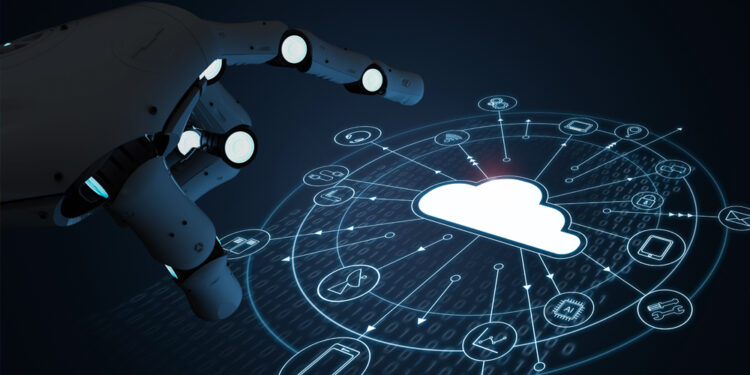The symbiosis between artificial intelligence (AI) and cloud computing is no longer a future concept; it is the driving force behind a new era of technological innovation. The cloud provides the boundless computational power, massive data storage, and scalable infrastructure that AI needs to thrive, while AI is fundamentally changing how cloud services are designed, managed, and consumed. AI Powering Cloud Innovation is a story of this dynamic partnership, a transformative relationship that is creating a more intelligent, efficient, and automated digital world. This article will provide a comprehensive look into the key areas where AI is reshaping the cloud, exploring how it is enhancing security, optimizing performance, and creating a new generation of smart services. We will delve into the strategic implications for businesses and developers, offering a deep dive into how this powerful alliance is defining the next chapter of cloud technology.
The Foundational Role of AI in Cloud Management

The traditional model of cloud management, with its manual processes and reactive approach, is no longer sufficient for the scale and complexity of modern cloud environments. AI is stepping in to automate these tasks, creating a more intelligent, proactive, and efficient cloud.
A. Automating Cloud Operations: AI is automating many of the manual tasks that are required to manage a cloud environment.
- Resource Provisioning: AI-powered tools can analyze an application’s usage patterns and automatically provision or de-provision resources, such as virtual machines and storage services, to meet demand. This not only saves money but also ensures that an application is always running at its optimal performance.
- Fault Detection and Prediction: AI can be used to analyze a cloud environment’s logs and metrics in real time, detecting a potential problem before it leads to a costly outage. It can, for example, detect a change in a server’s performance that is a sign of an impending hardware failure, allowing an administrator to take a proactive step to prevent the failure.
B. Optimizing Cloud Cost Management: Cloud cost management is a major pain point for businesses, and AI is providing a new level of insight and automation.
- AI for FinOps: The discipline of FinOps (Cloud Financial Operations) is being powered by AI and machine learning. AI-powered tools can analyze a company’s cloud spending and provide a new level of insights into where the waste is coming from.
- Automated Cost Optimization: AI can also be used to automatically make recommendations for cost optimization, such as a recommendation to downsize a virtual machine or to move a workload to a more cost-effective pricing model. This new era of automated cost management is a game-changer for businesses that are trying to rein in their cloud spending.
C. Enhancing Cloud Security: Cloud security is a top priority for businesses, and AI is providing a new set of tools to fight a growing array of cyber threats.
- Threat Detection: AI-powered security information and event management (SIEM) platforms can analyze vast amounts of log data in real time, detecting anomalies and potential threats that a human analyst might miss.
- Automated Remediation: The next generation of cloud security solutions can also use AI to automatically respond to a threat, for example, by isolating a compromised server or by blocking an attacker’s IP address. This new era of automated defense is a game-changer for businesses that are trying to manage the security of a large and complex cloud environment.
AI-Powered Cloud Services

The cloud is no longer just a platform for running applications; it is a platform for building a new generation of intelligent services. AI is being integrated into a wide range of cloud services, creating a new era of innovation.
A. Machine Learning as a Service (MLaaS): The major cloud providers are offering a suite of MLaaS services that make it easier for businesses to build, train, and deploy machine learning models.
- Simplified ML: MLaaS platforms abstract away the complexity of machine learning, allowing a developer to build a model without having to be a data science expert. This is democratizing AI, making it accessible to a much wider audience.
- Scalable and Cost-Effective: MLaaS platforms provide a scalable and cost-effective way to run machine learning models. A developer can, for example, use a MLaaS platform to train a model on a massive dataset and then deploy it to a serverless function that only runs when a new piece of data is received.
B. AI-Powered Data Analytics: The cloud is the foundation for a new era of AI-powered data analytics.
- Data Lakes and Warehouses: The cloud provides the massive data storage and processing power that is needed to build a data lake or a data warehouse. AI is being used to analyze this data to provide a new level of insights into a business’s operations, its customers, and its market.
- Predictive Analytics: AI can be used to analyze a company’s data to predict future trends, such as a customer’s churn rate or a product’s sales volume. This is a powerful tool for businesses that are trying to make more informed decisions.
C. AI for Application Development: AI is also being used to automate and enhance the application development process itself.
- AI-Powered Code Generation: AI-powered tools can be used to generate code, which can significantly reduce the development time and the risk of human error.
- AI for Testing and Debugging: AI can also be used to automate the testing and debugging of an application. An AI system can, for example, analyze a company’s code to find a bug before it is deployed.
D. The Rise of Cloud-Native AI: The future of AI is cloud-native.
- Serverless for AI: The serverless model, where a function only runs when an event is received, is an incredibly cost-effective way to run an AI model.
- Containers for AI: Containers are a popular way to package and deploy an AI model. They allow a developer to create a reproducible environment for their model, which is a key part of a machine learning workflow.
Strategic Implications for Businesses and Developers
The powerful alliance between AI and the cloud is creating a new set of strategic imperatives for businesses and developers. Companies that fail to adapt will be left behind in a new, automated, and intelligent digital world.
A. For Businesses:
- A New Business Model: The combination of AI and the cloud is enabling new business models. For example, a company can use AI to offer a personalized service to its customers, or it can use AI to automate its internal operations and reduce its costs.
- A Strategic Advantage: Companies that are using AI to optimize their cloud environment and to build new, intelligent services will have a significant strategic advantage over their competitors.
- Talent and Expertise: The talent and expertise required to manage a cloud environment is changing. A company must invest in a team of cloud engineers who are also experts in AI and machine learning.
B. For Developers:
- A New Skillset: The skills required to be a successful developer are changing. Developers must be knowledgeable about AI and machine learning, and they must be able to use the cloud to build and deploy intelligent applications.
- A New Mindset: The mindset of a developer is also changing. They must move from a focus on building a static application to a focus on building an intelligent service that is constantly learning and evolving.
- New Tools and Platforms: The future of application development will be defined by new tools and platforms that are designed to be a central hub for all of a company’s cloud and AI development.
C. The Ethical and Legal Imperatives: The powerful alliance between AI and the cloud is creating new ethical and legal imperatives.
- AI Governance: Companies must have a clear AI governance strategy that addresses issues of algorithmic bias, data privacy, and accountability. The legal and financial consequences of a biased AI can be immense.
- Data Privacy: The use of AI relies on vast amounts of personal data, and a company must ensure that it is in compliance with all relevant regulations, such as GDPR and CCPA.
- The “Black Box” Problem: The “black box” nature of many AI systems, where it is difficult to explain how a decision was made, is a major ethical and legal challenge. The future of AI will be defined by a new push for “explainable AI,” or AI systems that can explain their decisions in a way that is understandable to a human.
D. The Democratization of AI: The combination of AI and the cloud is democratizing AI, making it accessible to a much wider audience.
- New Opportunities: This is creating new opportunities for startups and small businesses, who can now use AI to compete with larger companies.
- A More Equitable Economy: The democratization of AI can also lead to a more equitable economy, where all businesses, regardless of their size, have access to the same powerful tools.
Conclusion
AI Powering Cloud Innovation is a story of a new era of technological innovation, one that is more intelligent, more efficient, and more automated. The challenges are immense, from the ethical implications of algorithmic bias to the legal complexities of data privacy. However, the opportunity is even greater: to build a more resilient, more secure, and more innovative digital world. The decisions we make today will not only shape the future of cloud and AI but also define our relationship with technology and the very concept of a digital business. The future of cloud computing is here, and it is a new era of intelligent automation, technological innovation, and a deep commitment to building a digital world that is designed for the future.









